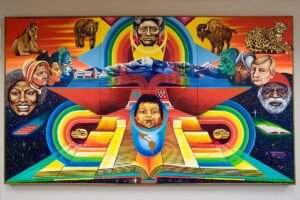
September 22, 2015; The Nation
There is no question that video devices have played an enormous role in the Black Lives Matter movement. They provide, in cases where there would have been disputed versions of reality, incontrovertible evidence that can be used in legal and advocacy settings. But it is still risky for the bystander to whip out a camera and start to film armed aggressors who have, by the by, been surveilling citizens like crazy.
Cop watching, of course has its roots in the Black Panther Party for Self Defense which started by monitoring police behavior in Oakland, California where police brutality had been rampant. They did so fully armed of course albeit with a set of clear principles and protocols, but in its newer forms cop-watching has recently been covered here by VICE and here by the New York Times , and now the tool of choice is the camera. The number of communities making use of organized some form of it continues to expand but the principle of it is also more mainstream. We will stay away from the recent history of the trend and its formal roots because we have read a number of versions. Rather we will discuss what it is.
Its intention is to create a kind of citizen monitoring system that provides more protections for those who may be more at risk of being at the butt end of police misconduct.
Copwatching is considered to be a form of sousveillance — a “watching from below” and the structure of it, when it is organized, is different from community to community according to Jose Martin who has participated in them both in Chicago and New York City.
“In New York, I think there are two different kinds [of copwatch],” says Martín. “One kind is the people on the block. On every block, somebody knows to film the police if the police are harassing people on their block. And then there’s a very different kind which is people doing patrols. Sometimes [copwatch] actually means organizing serious patrols and doing outreach, organizing specific groups or communities who request copwatch…when you organize amongst street vendors, people in gangs, sex workers, every copwatch is a little different because [of] the people who are doing it.”
Sign up for our free newsletters
Subscribe to NPQ's newsletters to have our top stories delivered directly to your inbox.
By signing up, you agree to our privacy policy and terms of use, and to receive messages from NPQ and our partners.
In New York City, nonprofits provide the majority of the copwatch trainings but elsewhere it has been less institutionally associated says Martín. There is even an apparently loosely structured Cop Watch Alliance.
Not only is the field divided into organized patrols and informal networks of people but there are special moments when a different kind of organization is done; for instance before Pride, when “LGBTQ-focused advocacy and nonprofit groups like FIERCE! and the Audre Lorde Project each held copwatch trainings that were standing room only.”
Martín suggests a set of ground rules for copwatching, like standing back to film so you cannot be seen as more than a neutral observer, training the camera on the police, and doing so in groups when possible and having attorneys that can be contacted. A number of practicing attorneys volunteer their time with organized copwatch patrols.
Rebecca Heinigg is one such attorney. “There’s a small group of volunteer attorneys,” she says “and whenever a team in a particular neighborhood has a patrol scheduled, they will send out an email asking if anyone is available to be the attorney on call for a team in East Flatbush or Sunset Park or Harlem, for example. And whoever is free responds with their cell phone number and contacts the person leading the patrol for that night. When they’re heading out, the patrol will text or call to check in and when they come back in safely at the end of the night, they check out with the attorney on call to let us know that they finished without incident,” Heinegg explains but she has not yet had to deal with an incident during one of the patrols.
“In New York, it’s actually in the NYPD patrol guide that it’s legal to film the police,” explains Heinegg. “There’s a consent decree called Black v. Codd that the city entered into back in the 1970s, stating that the court required the city to allow people to observe and document arrests as long as they’re not interfering. It’s really just common sense: you don’t physically interfere with what they’re doing in any way, you step back. It’s more likely to go smoothly if the person filming is not belligerent or aggressive with the police. You have to stand back a bit and just try to get a clear shot,” she says.
Further, says Martin, having people film those filming the police is an extra measure that prevents the police from taking action against those filming them. “For the person filming, you should try to stay quiet with the exception of documenting the exact time, date, location, or numbers on police vehicles. You should also have somebody else act as a liaison between the person filming and the police, to de-escalate for their protection,” he says.
Heinegg says that when police expect they may be filmed, they may behave differently and it restores a measure of civil dignity to the interaction. “It’s about bearing witness and making the police understand that you’re watching,” says Martín. –Ruth McCambridge











